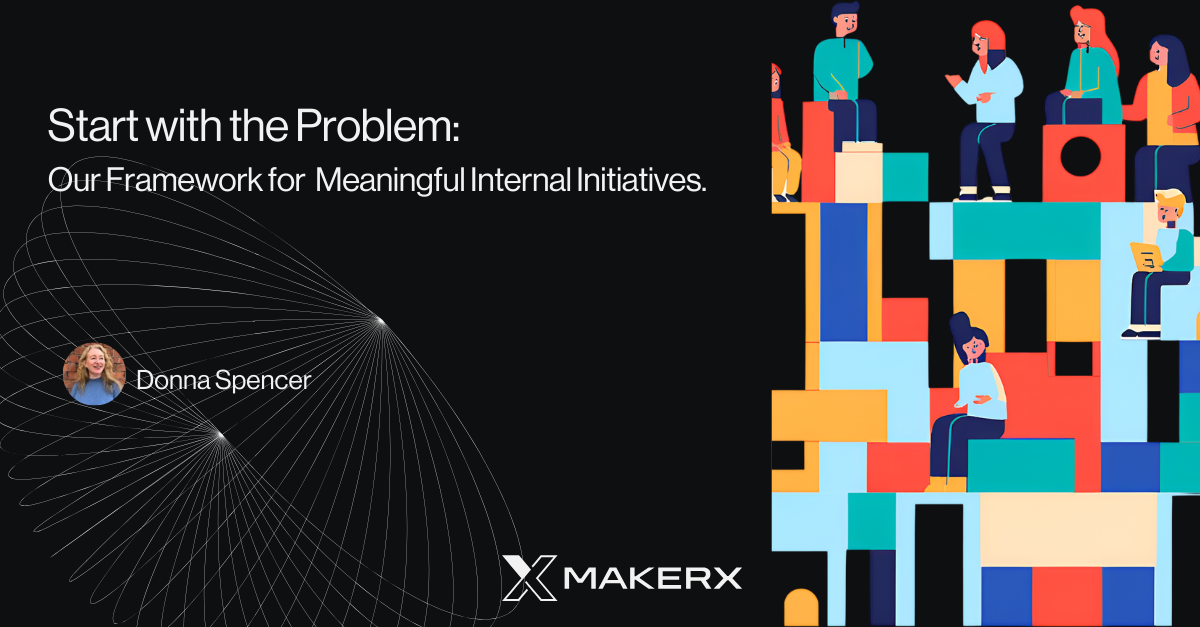Start with the Problem: Our Framework for Meaningful Internal Initiatives

As a small, new company, and with founders who love to try new things, we started with no fixed approach for many of our core business processes. We all have a genuine desire to create a company that works well for the whole team, now and into the future. And we don’t like just following what other companies do - company culture and individual needs mean that you can’t apply one company’s approach unless the context is identical.
Our ‘problem we were trying to solve’ (which became a bit of a catch cry) was to come up with solutions that suited our company and team, using the input of the team.
We called this our ‘internal initiative’ program and over our first few years, we worked on these initiatives:
- Remote engagement
- Career framework
- Mental health and wellbeing
- Onboarding
- Mentoring
- Diversity and inclusion
- Organisational structure
This post outlines how we tackled these as a team, and gives you a structure for doing the same in your company.
The approach
We didn’t start out with an up-front planned approach, but after a few initiatives, realised we were doing pretty much the same ‘process’ for each.
Describe the problem we are trying to solve
At the beginning of the initiative it’s important to spend time discussing and understanding the problem we are trying to address. The value of this step is probably clear - to make sure that everyone involved has the same frame of reference. However, it can be easy to forget if it seems that the topic is self-evident, or if we’re starting to talk about solutions too early. Many times we’ve stepped back and said ‘hang on, what’s the problem we’re trying to solve here’.
This step doesn’t have to be particularly difficult. Sometimes one person with a good understanding of the idea explains it to the group - this works well when the topic comes from one person or the idea actually is fairly clear. Sometimes we brainstorm the loose topic to see what everyone’s perspective is, then discuss what we want to be in scope and what is out of scope.
We do (try to) make sure we write down our conclusion. We’re not perfect at this, but people tend to stay involved with an initiative so, if we need to revisit the core problem, we usually have a decent shared memory. And because our workshops are all online, we always have the original discussion documented.
Understand the topic better
Next we research what is already being done in other organisations; or theoretical approaches to the topic. This gives us ideas about good practice; helps us understand what might go wrong; and generally helps us identify possible solutions that we might not have thought about. We do general internet research, reach out to contacts, and reflect on what we have experienced in other organisations. We then share what we learned with each other, which raises our collective understanding of the topic.
We don’t let any of this guide us towards a particular solution. It’s great background research, but we never use it to just ‘do what this company did’.
Brainstorm solutions
For me this is the most fun part! In this step we come up with a solid list of ways we could approach the topic.
We usually do some kind of brainstorming method - sometimes literally ‘what could we do here’, and sometimes a more structured set of workshop activities (we’ll describe some of these workshop methods over the next few months).
An important part of this brainstorming round is to discuss all the ideas by describing them in more detail to each other. We need to all to really understand possible ideas, and not assume they are obvious to everyone, before trying to figure out which ones to choose or experiment with.
Revisit the topic
Before we go on to deciding on next steps, we make sure we go back to the ‘what’s the problem we are trying to solve here', because:
- after research and brainstorming, we often think differently about the topic itself.
- our workshops may be a few weeks apart and it’s good to have a reminder the problem
- we often have a new team member involved which is a good trigger to revisit and potentially reframe the topic
We’ve quite often realised that the problem we thought we were trying to solve is actually a little different, and to change the definition of what we were tackling.
Decide
Once we have a pile of solid ideas, we first figure out how we are going to decide, then actually decide.
Yes, that is a 2 part process, and very deliberately so - the most important part of making a decision is to understand how it will be made.
Low-consequence decisions can be made with relatively light methods. For example, choosing experiments we might try for remote engagement is pretty low consequence - we know they are going to be experiments with a limited timeframe, we’ll review them, and we’ll be trying more than one - so it’s fine for the group to discuss, vote and implement.
High-consequence decisions should be decided using a method that suits the consequence. For example, some of our ideas in our diversity and inclusion initiative had to be legal, had consequences for company financials, and could significantly affect individuals. In this case the group discussed and prioritised ideas but the decision was made by our executive.
Define the solution or experiment
With an idea selected, we decide on the details of what we’re going to do or try. For example, for a short experiment, we figure out what the experiment is, who will do what and what we need to get in place for it. We prepare supporting materials (principles, instructions, demo videos).
We tell the team what we’re doing and how they can get involved (of course, we also do this as we go for initiatives that take a while to plan).
Then we do the thing. We observe what happens, and collect metrics if that’s how we decided to experiment.
Review and rework
At the end of a period of time, we review how the initiative went. Did it result in what we expected? (no, never, but that’s the interesting thing about an experiment). And we figure out what we might change next time around. As an example, we’ve rolled back a number of our experiments, which didn’t mean we had the wrong solutions, just that we didn’t know if they were right or not.
It’s all collaborative
The most important part of all of this is that it’s done by the team and anyone can get involved in anything they are interested in. It’s even a part of our remote engagement initiative that our team gets involved in initiatives!

